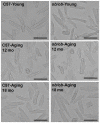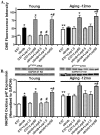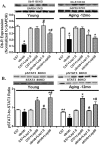Interaction between age and obesity on cardiomyocyte contractile function: role of leptin and stress signaling
- PMID: 20396382
- PMCID: PMC2852499
- DOI: 10.1371/journal.pone.0010085
Interaction between age and obesity on cardiomyocyte contractile function: role of leptin and stress signaling
Erratum in
- PLoS One. 2014;9(8): e105650. doi:10.1371/journal.pone.0105650
Retraction in
-
Retraction: Interaction between Age and Obesity on Cardiomyocyte Contractile Function: Role of Leptin and Stress Signaling.PLoS One. 2022 Jul 12;17(7):e0271530. doi: 10.1371/journal.pone.0271530. eCollection 2022. PLoS One. 2022. PMID: 35819974 Free PMC article. No abstract available.
Abstract
Objectives: This study was designed to evaluate the interaction between aging and obesity on cardiac contractile and intracellular Ca2+ properties.
Methods: Cardiomyocytes from young (4-mo) and aging (12- and 18-mo) male lean and the leptin deficient ob/ob obese mice were treated with leptin (0.5, 1.0 and 50 nM) for 4 hrs in vitro. High fat diet (45% calorie from fat) and the leptin receptor mutant db/db obesity models at young and older age were used for comparison. Cardiomyocyte contractile and intracellular Ca2+ properties were evaluated including peak shortening (PS), maximal velocity of shortening/relengthening (+/- dL/dt), time-to-PS (TPS), time-to-90% relengthening (TR(90)), intracellular Ca2+ levels and decay. O2(-) levels were measured by dihydroethidium fluorescence.
Results: Our results revealed reduced survival in ob/ob mice. Aging and obesity reduced PS, +/- dL/dt, intracellular Ca2+ rise, prolonged TR(90) and intracellular Ca2+ decay, enhanced O2(-) production and p(47phox) expression without an additive effect of the two, with the exception of intracellular Ca2+ rise. Western blot analysis exhibited reduced Ob-R expression and STAT-3 phosphorylation in both young and aging ob/ob mice, which was restored by leptin. Aging and obesity reduced phosphorylation of Akt, eNOS and p38 while promoting pJNK and pIkappaB. Low levels of leptin reconciled contractile, intracellular Ca2+ and cell signaling defects as well as O2(-) production and p(47phox) upregulation in young but not aging ob/ob mice. High level of leptin (50 nM) compromised contractile and intracellular Ca2+ response as well as O2(-) production and stress signaling in all groups. High fat diet-induced and db/db obesity displayed somewhat comparable aging-induced mechanical but not leptin response.
Conclusions: Taken together, our data suggest that aging and obesity compromise cardiac contractile function possibly via phosphorylation of Akt, eNOS and stress signaling-associated O2(-) release.
Conflict of interest statement
Figures










Similar articles
-
Interplay between obesity and aging on myocardial geometry and function: Role of leptin-STAT3-stress signaling.Biochim Biophys Acta Gen Subj. 2023 Feb;1867(2):130281. doi: 10.1016/j.bbagen.2022.130281. Epub 2022 Nov 18. Biochim Biophys Acta Gen Subj. 2023. PMID: 36410609
-
High-fat diet-induced obesity leads to resistance to leptin-induced cardiomyocyte contractile response.Obesity (Silver Spring). 2008 Nov;16(11):2417-23. doi: 10.1038/oby.2008.381. Epub 2008 Aug 14. Obesity (Silver Spring). 2008. PMID: 18719678
-
Impaired cardiac contractile function in ventricular myocytes from leptin-deficient ob/ob obese mice.J Endocrinol. 2006 Jan;188(1):25-36. doi: 10.1677/joe.1.06241. J Endocrinol. 2006. PMID: 16394172
-
Impaired cardiac function in leptin-deficient mice.Curr Hypertens Rep. 2008 Dec;10(6):448-53. doi: 10.1007/s11906-008-0084-0. Curr Hypertens Rep. 2008. PMID: 18959830 Review.
-
Fitness or fatness--the debate continues for the role of leptin in obesity-associated heart dysfunction.Curr Diabetes Rev. 2007 Aug;3(3):159-64. doi: 10.2174/157339907781368959. Curr Diabetes Rev. 2007. PMID: 18220667 Review.
Cited by
-
Extracellular matrix roles in cardiorenal fibrosis: Potential therapeutic targets for CVD and CKD in the elderly.Pharmacol Ther. 2019 Jan;193:99-120. doi: 10.1016/j.pharmthera.2018.08.014. Epub 2018 Aug 25. Pharmacol Ther. 2019. PMID: 30149103 Free PMC article. Review.
-
Retraction: Interaction between Age and Obesity on Cardiomyocyte Contractile Function: Role of Leptin and Stress Signaling.PLoS One. 2022 Jul 12;17(7):e0271530. doi: 10.1371/journal.pone.0271530. eCollection 2022. PLoS One. 2022. PMID: 35819974 Free PMC article. No abstract available.
-
Metabolic Stress, Autophagy, and Cardiovascular Aging: from Pathophysiology to Therapeutics.Trends Endocrinol Metab. 2018 Oct;29(10):699-711. doi: 10.1016/j.tem.2018.08.001. Epub 2018 Aug 22. Trends Endocrinol Metab. 2018. PMID: 30145108 Free PMC article. Review.
-
The Interconnections Between Somatic and Ovarian Aging in Murine Models.J Gerontol A Biol Sci Med Sci. 2021 Aug 13;76(9):1579-1586. doi: 10.1093/gerona/glaa258. J Gerontol A Biol Sci Med Sci. 2021. PMID: 33037434 Free PMC article. Review.
-
Surgically Metabolic Resection of Pericardial Fat to Ameliorate Myocardial Mitochondrial Dysfunction in Acute Myocardial Infarction Obese Rats.J Korean Med Sci. 2022 Mar 7;37(9):e55. doi: 10.3346/jkms.2022.37.e55. J Korean Med Sci. 2022. PMID: 35257523 Free PMC article.
References
-
- Cope MB, Allison DB. Obesity: person and population. Obesity (Silver Spring) 2006;14(Suppl 4):156S–159S. - PubMed
-
- Ren J, Kelley RO. Cardiac health in women with metabolic syndrome: clinical aspects and pathophysiology. Obesity (Silver Spring) 2009;17:1114–1123. - PubMed
-
- Bellisari A. Evolutionary origins of obesity. Obes Rev. 2008;9:165–180. - PubMed
-
- Miard S, Picard F. Obesity and aging have divergent genomic fingerprints. Int J Obes (Lond) 2008;32:1873–1874. - PubMed
-
- Jensen D, Ofir D, O'Donnell DE. Effects of pregnancy, obesity and aging on the intensity of perceived breathlessness during exercise in healthy humans. Respir Physiol Neurobiol. 2009;167:87–100. - PubMed
Publication types
MeSH terms
Substances
Grants and funding
LinkOut - more resources
Full Text Sources
Medical
Miscellaneous

